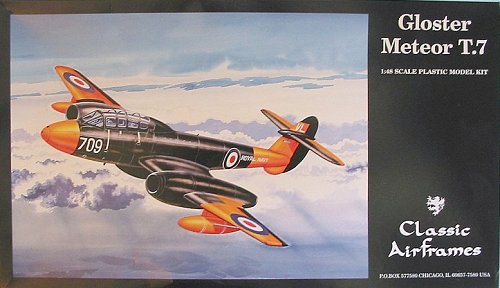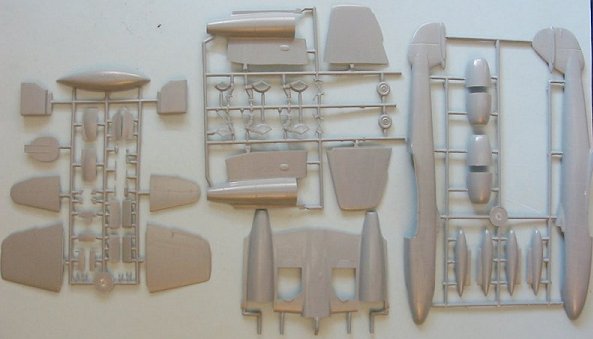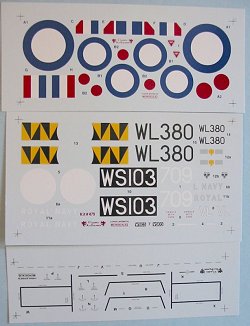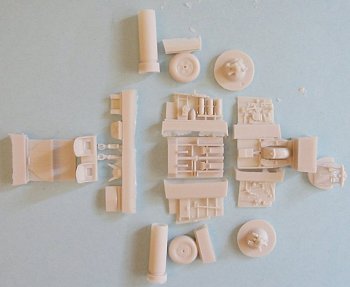
|
KIT: |
Classic Airframes 1/48 Meteor T.7 |
|
KIT # |
? |
|
PRICE: |
$59.95 MSRP |
|
DECALS: |
Two options |
|
REVIEWER: |
Tom Cleaver |
|
NOTES: |

|
HISTORY |
After three years of operating the Meteor, it was becoming obvious that there was a need for a trainer, so that new jet pilots could have the opportunity of learning more about their mounts before being turned loose on their own. This had been made very clear to Gloster after the crash of the F. Mk.4 demonstrator, G-AIDC, with a Belgian first-timer at the controls, the company decided that never again would they allow a Meteor to be flown without the supervision of their own test pilots.
The sale of 100 Mk. 4s to Argentina in 1947 brought 12 Argentine pilots to England for flight training. To instruct the students in the art of taxying, the canopy was removed from an F. Mk.4, so that the Gloster instructor could sit astride the fuselage behind the cockpit yelling instructions and signaling by hand until the students were proficient enough for a solo.
As a result of this, Gloster decided to privately develop a trainer based on the Mk.4 airframe, whose main change was a 30-inch extension to the forward fuselage to allow a second fully-equipped cockpit, and a heavily-framed canopy over both cockpits which opened to the right on the ground. Neither the prototype nor any operational Meteor trainers would be equipped with ejection seats.
The Gloster G.43 T.7 Trainer made its first flight on March 19, 1948. The performance was only slightly less than that of the single-seater. Official interest in the private-venture trainer was immediate, with the Air Ministry issuing Specification T.1/47 to cover an RAF version. The prototype, registered G-AKPK, was painted bright scarlet with cream letters, and toured several countries before eventually being sold to the Royal Netherlands Air Force in November 1948.
The production T.7 eliminated the need for nose ballast, replacing that with an extra 200-gallon fuel tank, while there was also provision for a 180-gallon ventral tank and two 200-gallon underwing tanks. The first production T.7, VW410, flew on October 26, 1948, while the last, XF279, was delivered July 27, 1954. Following final delivery to the RAF, the T.7 remained in production to fill orders from Belgium, France, Egypt, Brazil and Israel.
In service, the T.7 equipped several training squadrons; additionally, every operational Meteor squadron included at least one T.7. The Fleet Air Arm adopted the Meteor T.7 as its standard jet trainer, and used the airplane until the mid-1970s.
T.7 WA634 was utilized by Martin-Baker in the development of the Martin-Baker Mk.4 ejection seat, which was the first seat to have zero-zero capabilities. The first demonstration of this seat was performed by Squadron Leader John Fifield at Chalgrove Aerodrome on September 3, 1955. At a speed of 120 mph, Fifield fired the seat and was ejected to an altitude of 70 feet, his parachute deploying at 30 feet for a successful landing.
Because the T.7 could carry an observer, the aircraft was used in numerous engineering development programs until the mid-1970s, including development of the remote-control system for drones and the firing trials of the Firestreak AAM.
After numerous years as a station hack, the last T.7 finally left the RAF inventory in the early 1980s.
|
THE KIT |


 The only new
items in the kit as compared to the recent F. Mk.4 kit is the different
fuselage, with two very complete resin cockpits, and the distinctive
heavy-framed canopy. This canopy is injection molded, and while it is
very clear there is enough optical distortion in the plastic that the
modeler who wishes to display the detailed cockpit can only do so with
the canopy in the open position, which hinges it over to the right.
The only new
items in the kit as compared to the recent F. Mk.4 kit is the different
fuselage, with two very complete resin cockpits, and the distinctive
heavy-framed canopy. This canopy is injection molded, and while it is
very clear there is enough optical distortion in the plastic that the
modeler who wishes to display the detailed cockpit can only do so with
the canopy in the open position, which hinges it over to the right.
Decals include a squadron hack for 74 Squadron in camouflage from the mid-1950s, and a very colorful Fleet Air Arm station hack based at Yeovilton in the late 1960s, in overall satin black with large dayglo orange panels on the nose, rear fuselage and vertical fin, and outer wings. It should be noted that the X-tra Decals sheet that is made for the Meteor F. Mk.4 also includes several T.7s, including some very colorful target tugs.
|
CONCLUSIONS |
Another winner from Classic Airframes in their definitive series of Meteors. The only real difficulty I perceive with the model will be finding space to put sufficient weight inside to insure nose-sitting. I can foresee myself flattening numerous lead shot weights and stuffing them wherever I can to accomplish this. To me, itís a small price to pay to have an injection molded model of the one version of the Meteor I never expected to see in kit form.
Highly recommended!
Review Kit courtesy of Classic Airframes
If you would like your product reviewed fairly and quickly by a site that has nearly 250,000 visitors a month, please contact me or see other details in the Note to Contributors.